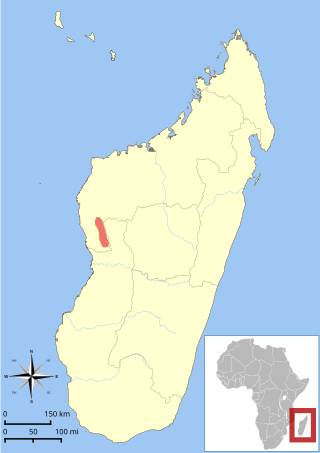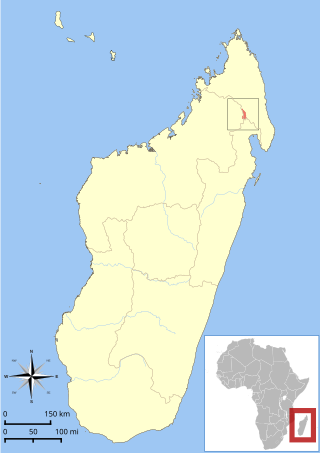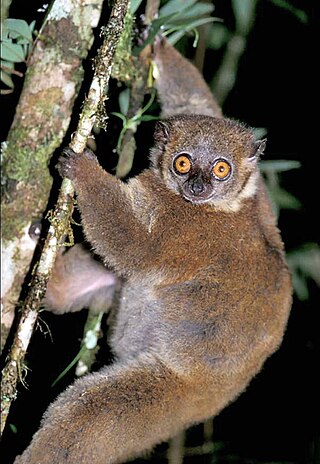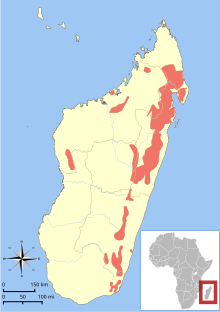
The Cheirogaleidae are the family of strepsirrhine primates containing the various dwarf and mouse lemurs. Like all other lemurs, cheirogaleids live exclusively on the island of Madagascar.

The Indriidae are a family of strepsirrhine primates. They are medium- to large-sized lemurs, with only four teeth in the toothcomb instead of the usual six. Indriids, like all lemurs, live exclusively on the island of Madagascar.

The Bemaraha woolly lemur, also known as Cleese's woolly lemur, is a species of woolly lemur native to western Madagascar, named after John Cleese. The first scientist to discover the species named it after Cleese, star of Monty Python, mainly because of Cleese's fondness for lemurs, as shown in Operation Lemur With John Cleese and Fierce Creatures, and his efforts at protecting and preserving them. The species was first recorded in 1990 by a team of scientists from Zurich University led by Urs Thalmann, but wasn't formally described as a species until November 11, 2005.

The eastern woolly lemur, also known as the eastern avahi or Gmelin's woolly lemur, is a species of woolly lemur native to eastern Madagascar, where it lives in the wet tropical rainforest at low elevations along the eastern coast of the island or they can also inhabit the northern tip of the island with other species. The woolly lemur name refers to their thick, tightly curled hair, whereas their generic name avahi refers to their high-pitched defensive call. The eastern woolly lemur almost has an owl-look with its large eyes, small rounded head, and ears that are mostly hidden. This nocturnal animal weighs 1.0–1.3 kg (2.2–2.9 lb) and reaches a length of 27–29 cm (11–11 in) with a tail of 33–37 cm (13–15 in). Its diet consists mainly of leaves and buds with fruits, flowers, and bark.

Mittermeier's mouse lemur is a species of mouse lemur known only from Anjanaharibe-Sud Special Reserve in Madagascar.

Simmons' mouse lemur is a species of mouse lemur known only from Betampona Special Reserve, Analalava Special Community Reserve near Foulpointe, and Zahamena National Park in Madagascar.

The Masoala fork-marked lemur, also known as the eastern fork-marked lemur or Masoala fork-crowned lemur, is a species of lemur found in the coastal forests of northeastern Madagascar. It is a small nocturnal animal with large eyes, greyish fur and a long tail.

The small-toothed sportive lemur, or small-toothed weasel lemur, is a primate species in the family Lepilemuridae that—like all extant lemurs—is endemic to Madagascar. The species lives in dense rainforest in southeastern Madagascar, and can be found in Ranomafana and Andringitra National Parks. Described in 1894, it was considered either a subspecies or taxonomic synonym of the weasel sportive lemur throughout most of the 20th century. Phylogenetic studies not only support its species status, but also suggest that it is the only eastern Malagasy sportive lemur that is more closely related to western than to other eastern species.

The dwarf lemurs are the lemurs of the genus Cheirogaleus. All of the species in this genus, like all other lemurs, are native to Madagascar.

Fork-marked lemurs or fork-crowned lemurs are strepsirrhine primates; the four species comprise the genus Phaner. Like all lemurs, they are native to Madagascar, where they are found only in the west, north, and east sides of the island. They are named for the two black stripes which run up from the eyes, converge on the top of the head, and run down the back as a single black stripe. They were originally placed in the genus Lemur in 1839, later moved between the genera Cheirogaleus and Microcebus, and given their own genus in 1870 by John Edward Gray. Only one species was recognized, until three subspecies described in 1991 were promoted to species status in 2001. New species may yet be identified, particularly in northeast Madagascar.

Sibree's dwarf lemur is a small nocturnal lemur endemic to Madagascar.

Moore's woolly lemur, or the Masoala woolly lemur, is a woolly lemur endemic to Madagascar. It has brown-grey fur and a reddish tail. It is named in honor of the Gordon and Betty Moore Foundation of San Francisco.

The southern woolly lemur, or southern avahi, has been recently recognized as a separate species of woolly lemur in 2006 by Zaramody et al. It is a nocturnal and pair-living species. Groups can range from 2 to 5 individuals. A study in Sainte Luce forest revealed home range varied from 2.2 to 3.5 ha and that males can have larger home range and cover longer daily distances than females, in agreement with the territory defence and mate guarding hypotheses.

The Betsileo woolly lemur or Betsileo avahi is a species of woolly lemur native to southeastern Madagascar, in the District of Fandriana. The pelage differs significantly from other southeastern woolly lemurs in that it is primarily light reddish brown on most of the body and grey under the jaw and on the extremities. The pelage is thicker on the head than other eastern woolly lemurs.

Peyrieras's woolly lemur or Peyrieras's avahi is a species of woolly lemur native to southeastern Madagascar. It weighs about 1 kg.

Ramanantsoavana's woolly lemur, also known as Ramanantsoavana's avahi or the Manombo woolly lemur, is a species of woolly lemur native to southeastern Madagascar. It weighs about 1 kg. It was originally considered a subspecies of the southern woolly lemur, A. m. ramanantsoavana, but was elevated to a separate species in 2006 based on molecular, phenotypic and morphological data.

Groves' dwarf lemur is a species of dwarf lemur known from Ranomafana and Andringitra national parks and surrounding areas in southeastern Madagascar. The identification was based on comparison of mitochondrial and nuclear gene sequences with other members of the C. crossleyi group. Individuals from this clade first came under genetic study in 1999 and were recognized as a new species in 2014, but it was not formally described until 2017. The lemur was named after mammalologist Colin Groves. Known from altitudes from 754 to 999 m, it is significantly larger than other members of the C. crossleyi group, with a 20 cm body length, a 29 cm tail, and a weight of 0.41 kg. While the conservation status of the new species has not yet been assessed, its presence in several national parks does not guarantee that it will not be threatened by deforestation ongoing on the island, or possibly by hunting.




















